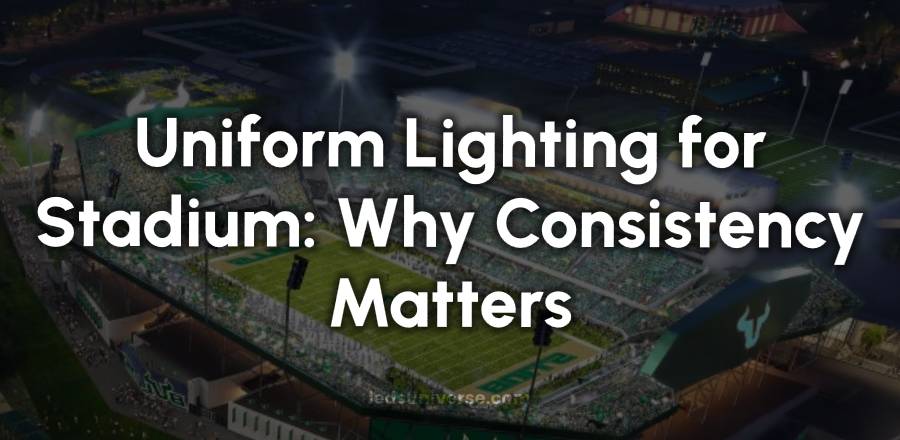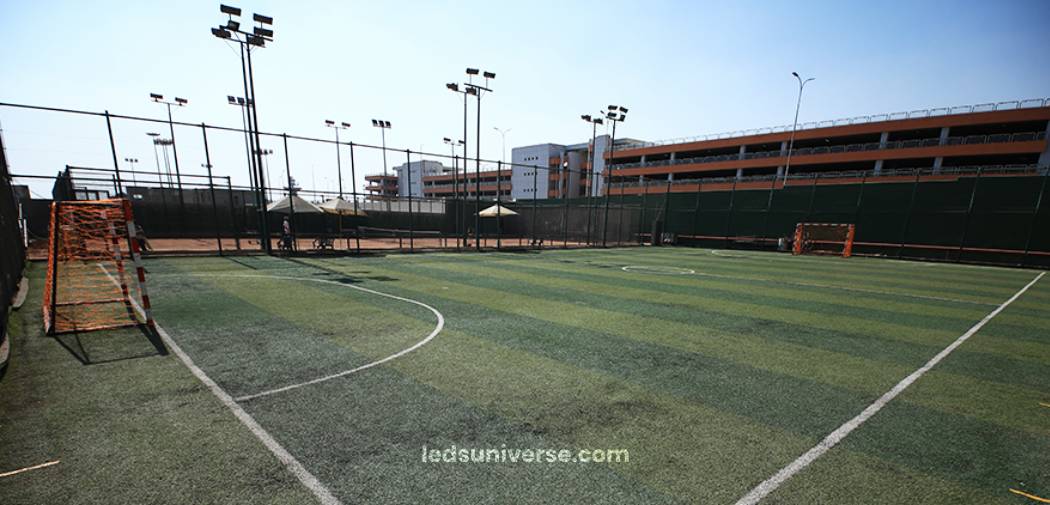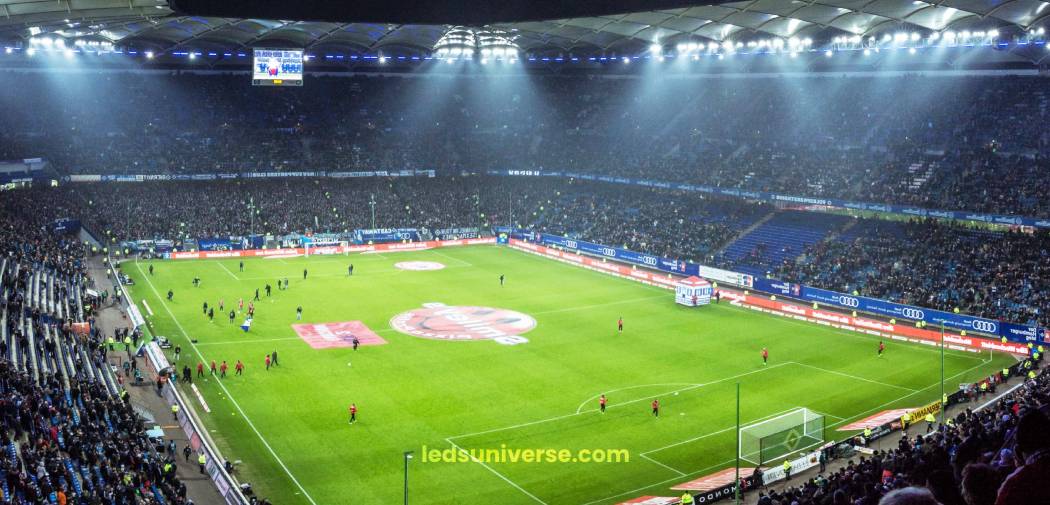
The excitement in the air is palpable as fans wear their team’s colors, waving flags and chanting. But what truly sets the stage for this electric atmosphere? The lighting. As the sun sets and darkness envelops the arena, the stadium lights illuminate the field, enhancing every moment—from dazzling goals to breathtaking performances.
Stadium lighting is an intricate and highly specialized aspect of stadium construction and management, designed to serve multiple functions. It not only provides visibility for athletes and fans but also enhances safety, broadcasting quality, and the overall atmosphere of the event. Whether for sports, concerts, or other large events, stadium lighting systems must be carefully designed and implemented to meet a wide range of specifications. This includes adhering to certain regulations, selecting appropriate lighting fixtures, achieving proper illuminance, and minimizing issues like glare and light spill.
Reach out for free lighting consultation
Table of Contents
ToggleStadium lighting must comply with several standards and regulations that ensure the proper functioning of lighting systems for various types of events. Different sports and events have their own specific requirements, with organizations like FIFA, UEFA, NCAA, and the Illuminating Engineering Society of North America (IESNA) setting detailed guidelines for stadium lighting.

For example, FIFA has established standards for football stadium lighting, focusing on illuminance levels, uniformity, and the color rendering index (CRI) for broadcasting purposes. UEFA’s lighting guidelines for European football matches specify the levels of light needed for both the playing surface and the spectator areas. IESNA also provides guidelines, particularly for stadiums hosting various types of events, from sports to concerts.
Outdoor stadiums may have additional regulations to follow, particularly concerning light pollution and energy efficiency. Some regions enforce restrictions on the amount of light spill into neighboring areas, which can impact wildlife and the surrounding community. Lighting systems also need to account for energy use, with many organizations and municipalities encouraging the use of energy-efficient lighting solutions like LEDs to reduce power consumption.
Stadiums that host high-definition (HD) and ultra-high-definition (UHD) broadcasts must also adhere to specific lighting standards. Broadcasting organizations require higher levels of illuminance to ensure the quality of live television feeds. Meeting these requirements often involves more advanced lighting technology to avoid flicker, ensure uniformity, and maintain color accuracy.
Different types of fixtures are used depending on the size and configuration of the venue, as well as the type of event being hosted. Traditional metal halide lamps have been widely used in stadiums for years, but newer technologies, particularly LED lighting, are increasingly favored for their performance, energy efficiency, and durability.
LED lights have revolutionized stadium lighting, providing a longer lifespan and greater energy savings compared to older metal halide systems. LEDs also offer enhanced control over lighting levels and can be easily integrated into smart lighting systems for dynamic adjustments based on the event. Additionally, LED lights can be dimmed, reducing power consumption when full brightness isn’t required.
Floodlights are commonly used in stadiums, casting wide beams of light across large areas. These are typically installed on high masts positioned around the stadium perimeter or on the roof to illuminate the playing field uniformly. Floodlights must be positioned and angled correctly to avoid casting shadows, especially during fast-moving sports like football, rugby, or athletics. Spotlighting may be used for more specific needs, such as focusing light on particular parts of the field or stage during events like concerts.
High-mast lighting systems, which can be over 40 meters tall, are another common feature in larger stadiums. These structures support multiple lighting fixtures designed to project light across long distances. High-mast systems are often found in stadiums that host a wide variety of events, as they provide a versatile solution for both sports and entertainment purposes.
Illuminance refers to the amount of light falling on a surface and is measured in lux. Different areas of a stadium, such as the playing field, seating areas, and concourses, have varying illuminance requirements depending on the type of activity taking place and the standards set by governing bodies.
For sports events, playing surfaces require a high level of illuminance to ensure athletes have sufficient visibility. Football fields, for example, are generally lit to levels of 500 to 2,000 lux, depending on whether the event is for amateur, professional, or broadcast purposes. Stadiums hosting international events or high-definition broadcasts may require levels upwards of 2,500 lux. For training or local-level matches, the lux levels can be significantly lower, often around 200 to 500 lux.
Horizontal illuminance, or the amount of light spread evenly across the field, is a consideration for stadium lighting design. Lighting engineers aim to achieve uniformity in horizontal illuminance so that there are no dark spots or areas of excessive brightness that could hinder player performance or spectator viewing. Vertical illuminance is also essential for televised events, ensuring that the players are well-lit from all angles to accommodate cameras placed around the stadium.
Illuminance uniformity is a parameter that measures the evenness of light distribution across the surface. The uniformity ratio is calculated by dividing the minimum lux level by the average lux level. Higher uniformity ratios are ideal because they reduce the chances of uneven lighting, which can create a patchy visual experience for both players and spectators. In most cases, a uniformity ratio of at least 0.6 to 0.7 is desirable.
Spectator areas, including seating and concourses, typically require lower levels of illuminance compared to the playing field. However, adequate lighting in these areas is necessary for ensuring safety and comfort, particularly during entry, exit, and emergency situations. Seating areas generally need to be illuminated to at least 150 lux, with concourse areas requiring around 50 to 100 lux.
While stadium lighting systems must achieve high levels of illuminance, they must also avoid issues like glare and light spill. Glare occurs when bright lights create visual discomfort, affecting the ability of players, spectators, and camera operators to see clearly. This can be particularly problematic during night games or events when artificial lighting is the primary light source.

Glare control in stadiums is achieved through careful positioning and angling of the lighting fixtures. Engineers often use specialized optics to direct light more precisely, reducing the likelihood of glare. Shielding can also be used to block excess light from entering areas where it is not needed, ensuring that the focus remains on the playing field or stage. Proper fixture placement and beam control are critical to maintaining visibility without overwhelming the eyes.
Light spill, or the unwanted spread of light into areas outside the stadium, can cause various issues, including light pollution and disturbance to nearby residential or natural areas. Light spill is a common concern for outdoor stadiums located in urban or environmentally sensitive areas. In some regions, local regulations require stadiums to limit the amount of light that escapes beyond the venue’s boundaries.
Engineers can control light spill by using more focused fixtures with adjustable beam angles and through the strategic use of shielding. LED lighting has proven particularly effective in reducing light spill because it allows for more precise control over where the light is directed. By minimizing the amount of light that escapes into the sky or neighboring areas, stadiums can comply with environmental regulations and reduce their impact on the surrounding ecosystem.
Several modern stadiums have implemented advanced lighting technologies that provide improved performance, energy efficiency, and an enhanced fan experience. These venues serve as case studies for how technological innovations are reshaping the future of stadium lighting.
One prominent example is Tottenham Hotspur Stadium in London, which opened in 2019 and is widely regarded as one of the most advanced sports venues in the world. The stadium’s lighting system is powered entirely by LED technology, offering not only the necessary illuminance for both sports and events but also incorporating smart lighting features that can adjust brightness and color in real time. The system is integrated with the venue’s audiovisual technology, creating stunning visual effects for concerts and special events. Tottenham Hotspur Stadium’s lighting also supports high-definition broadcasting, ensuring that the venue can meet the strict requirements of global sports events.
SoFi Stadium in Los Angeles is another example of a cutting-edge lighting design. The venue, home to both the NFL’s Los Angeles Rams and Los Angeles Chargers, uses an LED system capable of producing an extraordinary range of colors and effects. The system is designed to be energy-efficient, reducing power consumption compared to traditional lighting systems. In addition, SoFi Stadium’s lighting incorporates dynamic control features that allow the lighting to change based on the type of event or moment in the game, enhancing the overall atmosphere for fans.
Technological innovations in stadium lighting extend beyond just LEDs. Smart lighting systems are becoming more common in modern venues, allowing for real-time control and monitoring of lighting levels. These systems can be integrated into a stadium’s broader energy management infrastructure, making it possible to optimize power consumption based on current needs. For instance, lighting can be dimmed during periods of lower activity or increased when broadcasting requires higher illuminance.
Adaptive lighting is another emerging trend, where lighting systems automatically adjust based on real-time conditions, such as changing weather, time of day, or specific event requirements. These systems use sensors to monitor conditions and adjust lighting levels accordingly, ensuring optimal visibility while conserving energy.
Innovations in broadcasting, particularly the move to 4K and 8K resolutions, are also influencing stadium lighting design. These higher resolutions demand more precise lighting to ensure that the cameras capture every detail accurately. As a result, stadiums are upgrading their lighting systems to meet the demands of the next generation of broadcast technology, focusing on color accuracy, uniformity, and glare control.
Stadium lighting continues to evolve, driven by the demands of modern sports, entertainment, and sustainability considerations. With ongoing advancements in technology, stadiums around the world are adopting lighting solutions that not only meet regulatory requirements but also enhance the overall experience for players, spectators, and viewers.
From ensuring compliance with stringent standards to adopting innovative lighting technologies, stadiums are now equipped to provide exceptional visibility and an enhanced experience for athletes and spectators alike.
As venues continue to integrate smart technologies and renewable energy sources, the future of stadium lighting promises even greater efficiency, adaptability, and interactivity. Emphasizing safety, performance, and environmental responsibility, modern lighting systems are becoming essential components in creating memorable and engaging experiences in the world of sports and entertainment. The commitment to evolving these systems reflects a broader trend toward innovation and excellence in stadium design, ultimately benefiting everyone who steps foot in these iconic venues.